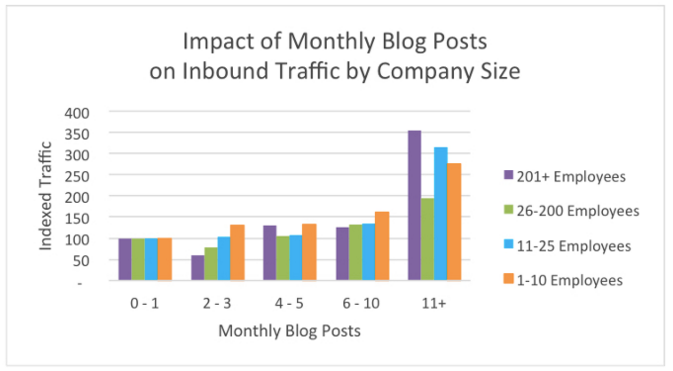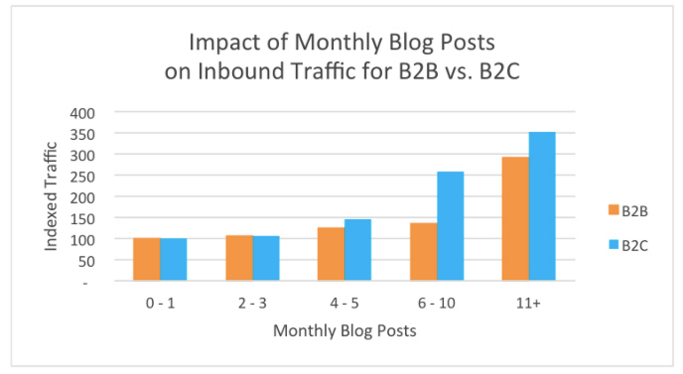Tell me if this sounds familiar: You decide on a blog topic, do all of the necessary research, maximize the article’s SEO potential, click publish, and share the blog post across social media. But then, as soon as it’s published you think, “Well, now what do I write tomorrow? Next week? Next month?”
Maybe you relate more to this scenario: You plan your content calendar months ahead of time with a variety of topics for your team to write. But after looking at your content calendar, you learn the topics being covered are repetitive and getting stale.
The question then becomes:
“How can I brainstorm and write blogs that are fresh and relevant to my business and my target audiences?” (Keep reading below.)
HubSpot’s most recent data shows that the more frequently a company blogs, the more inbound traffic they receive – regardless of company size:

Both B2B and B2C companies see an increase in traffic the more frequently they publish:

You may be asking yourself, “how can I publish more blogs if I don’t know what to write?”
You’re not alone, we’ve all been there.
There are many tools for coming up with blog post topics and, although helpful, these auto-generated titles often don’t make sense. So how can you as a blogger, content writer, or content marketing manager brainstorm and develop great blog topics continuously?
Here are 3 questions I’ve used in my blogging career to brainstorm topics and publish fresh, relevant articles.
1. What interests you?
Write about what interests you in your personal life (music, sports, movies, cooking, traveling, etc.) and relate it back to your product or service.
Movies and sports have always been my biggest passions: watching new releases the day they open in theaters, buying a DVD the day it comes out, watching the nightly SportsCenter to get my daily highlight fix, and listening to sports talk radio habitually.
So I figured out how to talk about all that, and my company’s niche, at the same time.
Example
One of my personal interests is football, and my company (Instapage) provides a user-friendly and customizable landing page builder.
With the beginning of the 2015 NFL season in September, I wrote an article that ties the two topics together: 5 Elements Your Landing Page and Football Have in Common.

Each point in the article uses “football language” and relates it to creating and optimizing a landing page. It also holds true to the blogging best practice of keeping the content clear with a list.
Not only is the football article a list, but it also relates two seemingly unrelated topics – increasing its chances of being shared on social media.
This example leads me to my next point…
2. What’s on the calendar?
Let the yearly calendar assist you and relate the event to your business.
Remember, these are “current” events so, naturally, you want to publish your article just before (or during) the event. Give people time to find it, and then act on it, before the current event has already happened.
This strategy is a little different than newsjacking, because you know these calendar events are happening in advance. Newsjacking events are breaking news situations and reacted to after the fact.
Example
One of my previous employers operates in the payments industry and their biggest target market is auto dealers. And for auto dealers, tax refund season can be a holiday of down payments for them.
Generating creative ways to encourage car shoppers to place a down payment is a constant struggle. Why else do you see ads promote holiday savings, cashback, and low-interest rates so often?
Car down payments are big-ticket items, so reminding auto dealer General Managers that car shoppers may have additional income to spend via tax refunds was an easy talking point.
Once I began researching and learned that taxpayers use their refunds on big-ticket items (like a new vehicle) the article almost wrote itself.
Besides writing the article for our target market, another reason this article works very well is the publish date.
Notice the March 9, 2015 publish date of the tax refund article above – right in the middle of tax season, and a prime time for taxpayers to receive refund checks. If I had written the article in the summer or around Christmas, it wouldn’t have made as much sense or received as many page views. Even posting it too far into tax season wouldn’t have been as effective.
What upcoming calendar event can you tie together with your business? Halloween? Thanksgiving? Black Friday? Small business Saturday? The opportunities are endless!
3. Blog comments & social media mentions
Chances are, your customers are subscribed to your blog already. But your blog is also a place for your prospects to learn more about you.
If prospects see you providing helpful tips on your blog to make their job easier, to help them sell more, to help save them money; they’ll develop more trust with you.
This trust is not only displayed in the articles themselves, but also when you respond to blog comments.
This is a perfect example how a blog can develop trust with its readers. Or, as Groove states, “by talking to our customers and solving problems for them … we build deeper relationships with people and make them more likely to want to do business with us.”
Maybe you have a landscaping blog and a reader asks which type of grass is best to plant for his home in Florida. You could write an article that explained the top grass types to plant in each type of climate. Or, let’s say you have a photography blog and one of your Twitter followers asks what camera setting is best to capture the sunset over the Golden Gate Bridge. Your article could detail not only the best camera settings but also the best locations to capture the perfect image.
Example
A CoSchedule blog reader asked the following question:

The blog’s author responded saying he was writing it down to have the idea as a topic for a future article. This creates an expectation in the reader’s mind to keep following CoSchedule’s blog to learn when her question will be answered.
Of course, CoSchedule followed through on their promise, writing this article in response to Ella’s blog comment and responding in-kind:

One way to bring this idea full circle is to go back to the original blog comment and insert your new article’s link – just like Nathan did in the screenshot above.
Wrapping Up
Without brainstorming fresh blog topics, publishing great content can be a constant struggle. The three tips above may not completely fill your content calendar, but they can certainly assist you in creating at least a few articles each month.
What ways do you generate blog topics? What topics do your readers tend to enjoy more? Feel free to leave a comment below and share your own blog brainstorming ideas!







